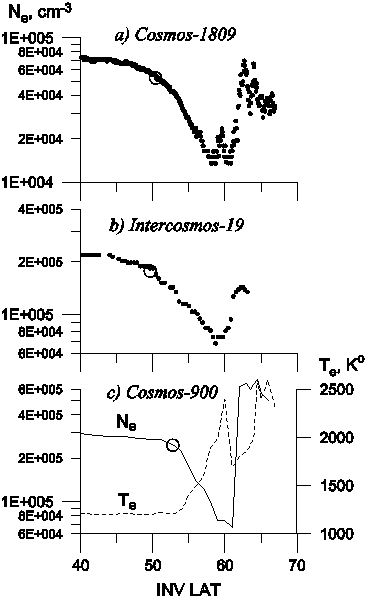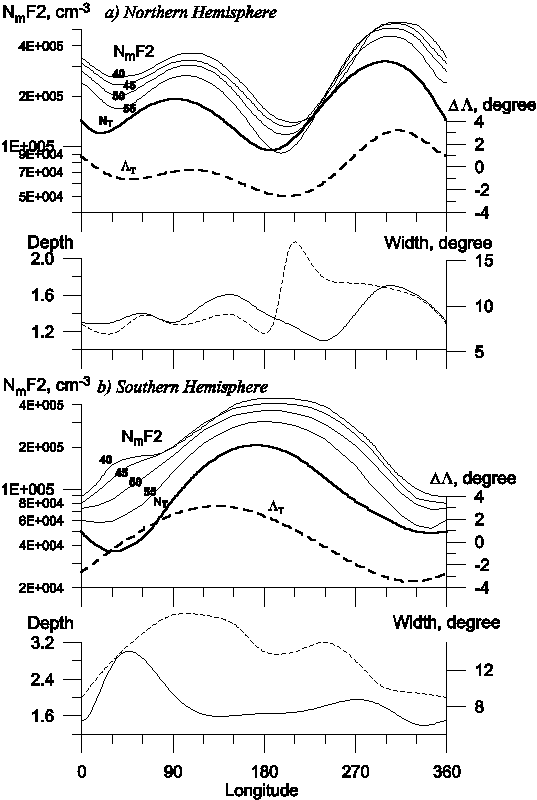
|

Pushkov Institute of Terrestrial Magnetism, Ionosphere and Radio Wave Propagation Russian Academy of Sciences ( founded in 1939 ) |

|
| Language [RU/EN] |
| Home | UP | Research | Projects | Services | Info | News | Events | Personal | Archive |
|
The dependence of the main ionospheric trough shape on longitude, altitude, season, local time, and solar and magnetic activityA. T. KarpachevInstitute of Terrestrial Magnetism, Ionosphere, and Radiowave Propagation, Russian Academy of Sciences, Troitsk, Moscow region, 142190 Russia e-mail: karp@izmiran.ru Pages: 1 | 2 | 3 | 4 | 5 Variations in the main ionospheric trough (MIT) shape are studied based on Intercosmos-19, Cosmos-1809, and Cosmos-900 satellite data. The main dependences are revealed and the causes of the strong differences between results of different studies are analyzed. In particular, it has been shown that an analysis of the MIT shape variations without taking into account the corresponding longitude and hemisphere leads to contradictions. It is also shown that the problem of the MIT shape variations with increasing magnetic activity cannot be solved merely by a data averaging. This problem becomes especially difficult at low solar activity. The MIT shape variations are governed by the longitudinal-latitudinal variations in the electron concentration in the trough region, in turn, dependent on several factors. The influence of the main factors, such as the illumination of the high-latitude ionosphere, neutral wind, electric field of the magnetospheric convection, and auroral particle precipitation, is qualitatively discussed. The MIT shape depends on many factors including altitude, longitude, local time, season, and solar and geomagnetic activity. The following example can demonstrate the degree of the dependence: a deep and narrow trough is always observed in summer night-time conditions at a solar activity minimum, whereas during a solar activity maximum a weakly pronounced trough is formed only at nonsunlit longitudes or at high magnetic activity [Besprozvannaya, 1975; Karpachev, 1995, 1996]. Though fairly much attention has been paid to MIT shape studies, the majority of the questions related to MIT shape are yet obscure and contradictory. For example, Ben'kova et al. [1993] claim that the trough is most developed at heights of the F2 layer maximum. The vertical cross section of the topside ionosphere obtained by Mendillo and Chacko [1977] demonstrates that the depth of the trough does not change at heights of 450-950 km. However, according to Legen'ka [1974], the trough depth increases to heights of 800-1000 km. One third of the publications states that MIT becomes narrower and deeper with increasing magnetic activity. In the second third, it has been found that the MIT becomes less pronounced. In the rest of the publications, no pronounced dependence was detected. Based on Intercosmos-19 data for only one longitudinal sector (20-70oE) in the Northern Hemisphere, Ben'kova et al. [1988] revealed at least four types of troughs strongly different in their shape. In the relatively old publication, this situation was assessed in the following way: "An analysis of diurnal, seasonal, and altitude variations in the trough characteristics leads to a confusion" [Ahmed et al., 1979]. The situation has changed slightly since then. Meanwhile, the ignorance of the MIT shape variations hinders the solution of many problems. In particular, this leads to considerable uncertainties in solving trajectory problems for radiowave propagation across polar regions of the ionosphere [Blagoveshchensky and Zherebtsov, 1987]. Therefore, radiophysicists should use in calculations a crude approximation made in the Halcrow and Nisbet [1977] model or determine trough parameters using the HF-network signals [Blagoveshchensky and Borisova, 1995]. The MIT characteristics (width, depth, height and wall steepness) strongly affect the propagation (guiding) of different natural and artificial signals [Kleimenova et al., 1995, Blagoveshchensky et al., 1997; Clilverd et al., 1995]. The aforesaid has specified the goal of this paper: based on a large data array, to study the MIT shape dependence on different factors, to establish the main regularities, and to understand the causes of contradictions between different studies in order to make progress in solving the problems stated. There is no commonly used MIT definition [Galperin et al., 1990]. A point of inflection in the latitudinal profile of Ne at the MIT equatorial wall is used to determine the presence of MIT. If a background decrease in Ne towards high latitudes (related mainly to the decrease in the solar zenith angle and in the O/N2 ratio) replaces by a more steep decrease caused by an additional factor, then a deep minimum of Ne formed at subauroral latitudes is defined as a trough. According to this definition of MIT, its width and depth are counted from an inflection point at Ne latitudinal profile. For example, in Fig. 1c the inflection point is located at invariant latitudes (  ) of 52-54o. In reality, the location
of an inflection point
and, consequently, the discussed MIT characteristics are often determined rather uncertainly
(e.g., see Fig. 1a). To avoid the uncertainty, the MIT width is determined at levels of
1.5Nmin or 2Nmin. However,
this method may lead to even larger uncertainties in the MIT
width. The MIT depth is sometimes determined relative to the MIT polar wall which is as
a rule more pronounced than the equatorial wall at heights of the F2 layer. However, the
spread in data at the polar wall is very considerable and so the depth becomes widely variable.
Therefore, we will consider that the first method is physically most adequate in spite of its
imperfection. ) of 52-54o. In reality, the location
of an inflection point
and, consequently, the discussed MIT characteristics are often determined rather uncertainly
(e.g., see Fig. 1a). To avoid the uncertainty, the MIT width is determined at levels of
1.5Nmin or 2Nmin. However,
this method may lead to even larger uncertainties in the MIT
width. The MIT depth is sometimes determined relative to the MIT polar wall which is as
a rule more pronounced than the equatorial wall at heights of the F2 layer. However, the
spread in data at the polar wall is very considerable and so the depth becomes widely variable.
Therefore, we will consider that the first method is physically most adequate in spite of its
imperfection.

2. DATA The large data set of Intercosmos-19 (~300 orbits), Cosmos-1809 (~100 orbits), and Cosmos-900 (~1200 orbits) data is used to analyze MIT characteristics. Data have been obtained both for high (F10.7 ~ 200, 1979-1980) and low (F10.7 ~ 70, 1986-1987) solar activity. They cover all longitudes in both hemispheres, the 1800-0600 LT time interval, and the magnetic activity range Kp = 0-8. Topside sounding data onboard the Intercosmos-19 and Cosmos-1809 satellites can be obtained within the entire range from the height of the F2 layer maximum to the height of the satellite. The Intercosmos-19 satellite had got an elliptical orbit with an altitude varying from 500 to 1000 km. As an example, the MIT registered by Intercosmos-19 at a height of 600 km at 0430 LT on September 30, 1980 (Kp = 2o) in the Northern Hemisphere is shown in Fig. 1b. The MIT polar wall is less pronounced then the equatorial wall; however, the trough is fairly deep and is easily observed. The Cosmos-1809 satellite had an almost circular orbit with a height of about 1000 km. Figure 1a shows the MIT registered onboard Cosmos-1809 at 1800 LT on January 10, 1989 (Kp = 3-) at a height of 1000 km in the Northern Hemisphere. Both walls of the trough are equally pronounced. The trough bottom has a complicated structure caused by the prehistory, which will also be discussed below. The Cosmos-900 satellite had a circular orbit. Its altitude decreased during the observations from ~500 to ~350 km. Figure 1c shows MIT registered by Cosmos-900 at 0055 LT on July 26, 1979 (Kp = 2-) at a height of about 375 km in the Southern Hemisphere, i.e., almost at a maximum of the nighttime F2 layer. A peak of Te usually accompanies a trough in Ne [Smilauer and Afonin, 1983]. As a rule, more pronounced troughs correspond to more distinct peaks in Te (e.g., see Fig. 1c). A Te peak is observed at latitudes of the trough bottom, but a Te maximum not always coincide with an Ne minimum (see also Fig. 1c). The location of a trough minimum can vary with longitude by 10-11 at different latitudes, and the electron concentration can change by an order of magnitude [Deminov and Karpachev, 1986a]. This leads to considerable variations in the trough shape with longitude. An ignorance of this fact often leads to contradictions. Therefore, we should start analyzing the MIT shape variation from the longitudinal effect (LE). The trough shape dependence on longitude (even based on satellite data) was traditionally analyzed by comparing data for two or three longitudinal sectors [Ben'kova and Zikrach, 1983; Besprozvannaya, 1975; Besprozvannaya and Makarova, 1984; Tulunay, 1973]. However, it is impossible to determine the LE character and, especially, to understand causes of its formation on the basis of two-three points. We analyze the MIT shape variations with longitude on the basis of the global (for all longitudes) distribution of NmF2 in the MIT region. Figure 2 shows the longitudinal variations in NmF2 at fixed invariant latitudes and at a trough minimum and in the location of a trough minimum in the Northern and Southern hemispheres. The variations are revealed by averaging the data array obtained onboard the Intercosmos-19 satellite for the near-midnight (0000 - 0200 LT) winter (December-January) quiet (Kp <= 3) conditions at high solar activity (F10.7 ~ 200). A striking feature is a strong asymmetry in the hemispheres both in the position of a trough minimum and in the electron concentration in the entire trough region. The amplitude of the NmF2 longitudinal variation at a trough minimum in the Northern Hemisphere is A = Nmax/Nmin ~ 4. At the same time, the minimum (0.9x105 cm-3) and maximum (3.4x105 cm-3) of NmF2 are reached at longitudes of 190-200o and 300o E, respectively. 
The amplitude of the NmF2 longitudinal variations in the Southern Hemisphere is larger then in the Northern Hemisphere and reaches ~5.5 at a trough minimum. At the same time, Fig. 2b shows that the minimum (3.7x104 cm-3) and maximum (2.1x105 cm-3) of NmF2 are observed at longitudes of 30o and 170-180o, respectively. The amplitude of the longitudinal effect on the trough location is also larger in the Southern Hemisphere then in the Northern Hemisphere (6o and 5o, respectively). The causes of LE on the trough location and form were qualitatively analyzed by Deminov and Karpachev [1986a] and Deminov and Karpachev [1986b], respectively. The causes of the NmF2 and hmF2 longitudinal variations in the trough region will be studied in detail on the basis of calculations in the next paper. So, omitting the causes of LE, we note here the main points. The position of a trough minimum and the plasma concentration in the trough are widely variable with longitude. The Ne longitudinal variations in the mid-latitude Northern Hemisphere are similar to the Ne variations at a trough minimum but differ in their phase and amplitude. In the Southern Hemisphere they are also considerably different in form. As a result, the trough shape varies with longitude. Next page » |
 |
|
(C) 2007, IZMIRAN
|

